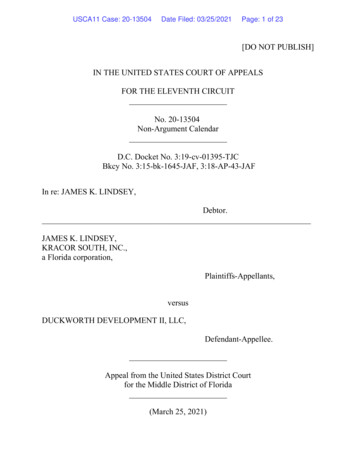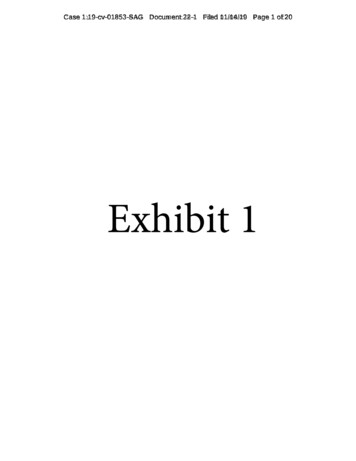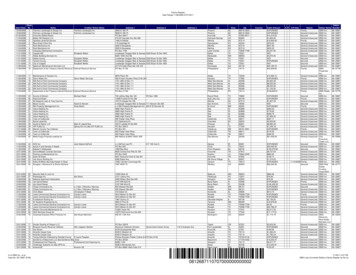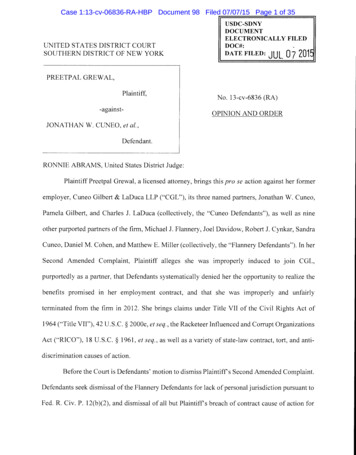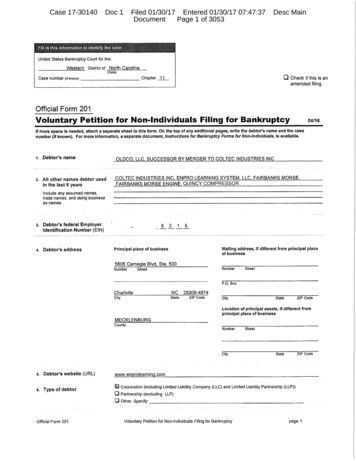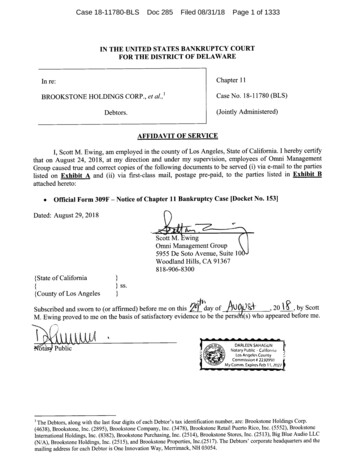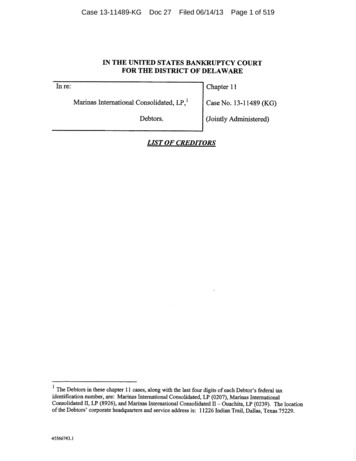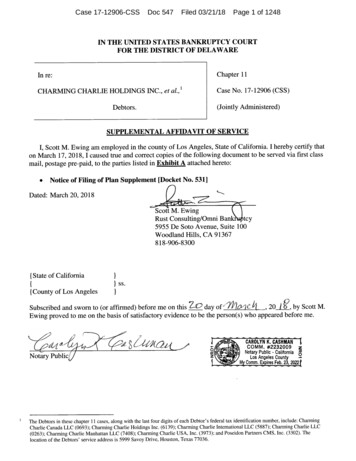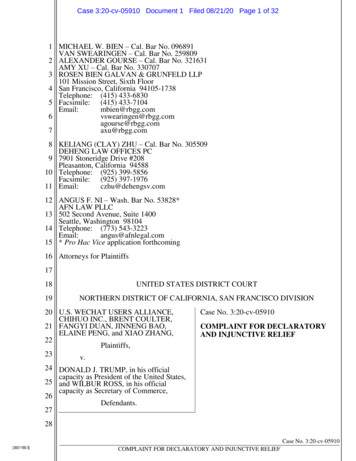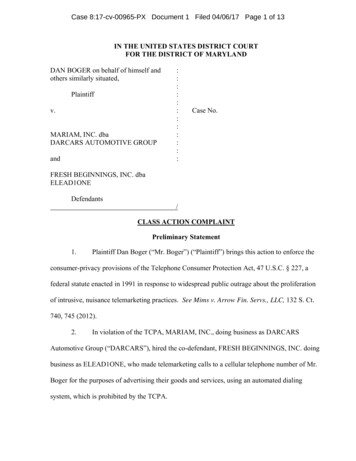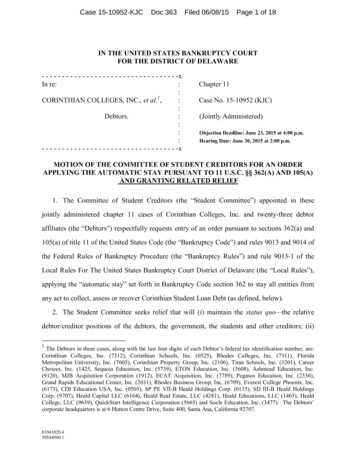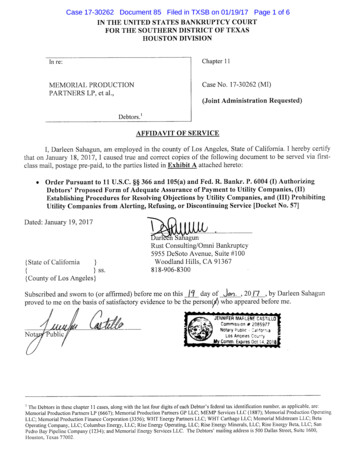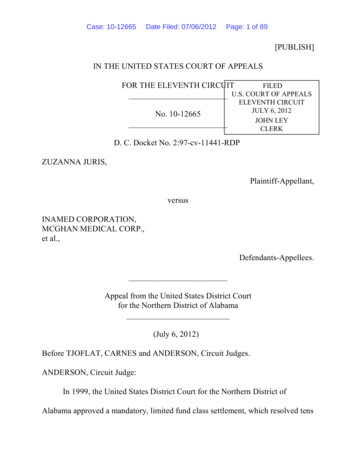
Transcription
Case: 10-12665Date Filed: 07/06/2012Page: 1 of 89[PUBLISH]IN THE UNITED STATES COURT OF APPEALSFOR THE ELEVENTH CIRCUITFILEDU.S. COURT OF APPEALSNo. 10-12665ELEVENTH CIRCUITJULY 6, 2012JOHN LEYCLERKD. C. Docket No. 2:97-cv-11441-RDPZUZANNA JURIS,Plaintiff-Appellant,versusINAMED CORPORATION,MCGHAN MEDICAL CORP.,et al.,Defendants-Appellees.Appeal from the United States District Courtfor the Northern District of Alabama(July 6, 2012)Before TJOFLAT, CARNES and ANDERSON, Circuit Judges.ANDERSON, Circuit Judge:In 1999, the United States District Court for the Northern District ofAlabama approved a mandatory, limited fund class settlement, which resolved tens
Case: 10-12665Date Filed: 07/06/2012Page: 2 of 89of thousands of claims arising out of injuries allegedly caused by defectivesilicone breast implants manufactured by Inamed Corporation (“Inamed”).Several years later, in 2006, Zuzanna Juris filed an individual action in Californiastate court against Inamed and Allergan, Inc. (“Allergan”), Inamed’s successor,alleging injuries caused by her Inamed implants. The defendants contended thatJuris’s lawsuit was barred because the 1999 class settlement resolved her claims;Juris posited that she could avoid the settlement’s res judicata effect on dueprocess grounds. The district court held that the class settlement precluded Jurisfrom prosecuting the California case. This is Juris’s appeal.For the reasons explained below, we affirm.I. BACKGROUND 1Well after the creation of silicone breast implants, women implanted withthem began claiming that leaking gel was causing them various diseases. In 1992,the Food and Drug Administration (“FDA”) first banned the use of silicone gelimplants, and a flood of litigation followed. The FDA relaxed the ban later thatyear to permit the use of such implants for specified medical procedures. The1The district court should be commended for the comprehensive narrative in whichit set forth this case’s complex procedural and factual history. Throughout Part I.A through E,we borrow in large part from the findings of fact in the district court’s memorandum opinion.2
Case: 10-12665Date Filed: 07/06/2012Page: 3 of 89number of lawsuits only increased further. As a result, the Judicial Panel onMultidistrict Litigation consolidated more than 21,000 cases against various breastimplant manufacturers for pretrial proceedings and transferred them to DistrictJudge Sam Pointer in the Northern District of Alabama.2 See In re Silicone GelBreast Implants Prods. Liab. Litig., 793 F. Supp. 1098 (J.P.M.L. 1992); In reSilicone Breast Implants Prods. Liab. Litig., MDL 926, 2:92-cv-10000 (N.D.Ala.). The transfer included all pending federal lawsuits against Inamed regardingallegedly defective implants.A. Inamed’s Pre-Settlement Financial ConditionIn 1991, women with Inamed breast implants began filing individual suitsagainst Inamed and its subsidiaries. The litigation ballooned. At one point, morethan 15,000 lawsuits were pending against Inamed across the country. Breastimplant litigation forced the company to divert substantial capital to fundingdefense efforts. In 1994, in an attempt to stem the tide, Inamed and the plaintiffs’settlement committee negotiated a global settlement agreement, which would haverequired Inamed to pay 1 million per year for twenty-five years. Anticipating2Troubled by allegations of forum shopping, litigation strategies, and underlyingmotives, the multidistrict panel rejected the forum preferences of both sides and independentlyassigned the case to Judge Pointer in light of his experience and reputation.3
Case: 10-12665Date Filed: 07/06/2012Page: 4 of 89approval of that proposal, Inamed booked the 25 million annuity as a contingentliability in the amount of 9.2 million (the present value of twenty-five annualpayments of 1 million). Inamed sought to certify a limited fund settlement classpursuant to Federal Rule of Civil Procedure 23(b)(1)(B) in an effort to secure amandatory, global resolution of all present and future claims. The plaintiffs’settlement committee retained Ernst & Young to review Inamed’s finances anddetermine whether limited fund treatment was appropriate. Ernst & Young issueda report confirming Inamed’s claims that its liabilities, both operational andlitigation-related, dwarfed its assets. Counsel for the plaintiffs did not dispute this.However, they questioned whether the 9.2 million present value contribution wasprudent considering Inamed’s potential future earnings. Disagreement yieldedfurther negotiations, and the possibility of a global settlement languished.Responding to its growing financial troubles, in 1996, Inamed approached ahigh risk investment group and raised 35 million through the private placementof senior secured convertible notes. The notes were senior to all claims, includingoperational liabilities and tort claims, and were secured by interests insubstantially all of Inamed’s assets. Pursuant to the terms of the offering, Inameddeposited 15 million in escrow for the sole purpose of financing a non-opt-outclass settlement if approved before January 23, 1997. That temporal condition4
Case: 10-12665Date Filed: 07/06/2012Page: 5 of 89was not met. Inamed returned the 15 million to the noteholders in exchange forwarrants to purchase Inamed common stock in the event a mandatory classsettlement was later approved. Inamed quickly exhausted the balance, 20million, which provided necessary cash to stay in business and cover expendituresrelated to inventory, payments to vendors, and other operational items.In January of 1997, Inamed secured an additional 6.2 million throughanother private debt placement. All proceeds were immediately applied towardsday-to-day operational expenses and payments against past-due income taxliabilities. Around this time, Inamed defaulted on its repayment obligations underthe senior secured notes and its stock price dropped. The company continued toexplore options for raising working capital. However, between the senior securednoteholders exercising their veto authority over Inamed’s ability to raise capitalthrough equity offerings and, more generally, the unavailability of commerciallyreasonable lending opportunities given the company’s dire financial predicament,Inamed’s only option was to borrow approximately 10 million from an entityassociated with its former chairman.Throughout the 1990s, each audit letter prepared by Inamed’s independentauditing firm, Coopers & Lybrand, included a qualified opinion expressing“substantial doubt about the Company’s ability to continue as a going concern.”5
Case: 10-12665Date Filed: 07/06/2012Page: 6 of 89For fiscal years 1995, 1996, and 1997, Inamed reported pre-tax operating losses of 8.6 million, 6.0 million, and 6.6 million, respectively. By the end of 1997, thecompany’s consolidated book value—subtracting liabilities from assets—wasnegative 10.9 million. Setting aside the 9.2 million contingent liability bookedin 1994 in anticipation of the proposed global settlement, Inamed’s book valuewas still negative 1.7 million. And, significantly, other than the 9.2 millioncontingent liability, Inamed’s balance sheet did not account for any other litigationexpenses, including possible settlements, attorneys’ fees, and potential judgments.Those litigation expenses, however, were staggering. For example, it costInamed’s attorneys approximately 150,000 to take a single case to the brink oftrial, and an additional 150,000 to defend through trial. In 1997 alone, Inamedsettled sixteen breast implant cases. The settlement values ranged from 2,500 to 50,000, averaging out to 18,500 per case.3 During this time, neither Inamed norits subsidiaries had products liability insurance coverage.In light of Inamed’s rapidly deteriorating financial condition, in the latterpart of 1997, the company and plaintiffs’ counsel revisited settlement negotiations.By this time, investors were unwilling to finance any settlement that would not3In addition, an individual case that went to trial against Inamed couldproduce—and in the past had produced—a multimillion dollar jury verdict.6
Case: 10-12665Date Filed: 07/06/2012Page: 7 of 89extinguish substantially all of the breast implant litigation. They consideredelimination of the enormous costs and risks associated with the implant litigationan essential precondition to the economic turnaround that would be necessary torepay any investment. Coupling this pressure with the senior secured noteholders’authority over Inamed’s financial decisions, Inamed’s ability to afford anysettlement was dependent on the senior creditors’ willingness to finance it.The parties considered the possibility of Inamed pursuing bankruptcy.Chapter 7 liquidation, as opposed to Chapter 11 reorganization, was the onlyviable solution to Inamed’s financial stresses. If Inamed had elected to pursueChapter 7 bankruptcy at the end of 1997, the company’s saleable assets,discounted by the impairment likely to result from a forced liquidation, wouldhave totaled between 11.4 million and 20.4 million. From this sum, the seniorsecured noteholders would have been entitled to 19 million, leaving unsecuredcreditors—trade creditors, subordinated noteholders and tort claimants—withsomewhere between 0 and 1.4 million. At best, the tort claimants would havebeen left to compete for 1.4 million against trade creditors, with rights topayment valued at 12.5 million, and subordinated noteholders, with rights topayment valued at 10 million.Plaintiffs’ counsel, including Ernest Hornsby, an attorney designated to7
Case: 10-12665Date Filed: 07/06/2012Page: 8 of 89represent the interests of Inamed breast implant recipients with potential, futureinjury claims, negotiated with Inamed and its senior secured noteholders.4 Thesenior secured noteholders—the only lenders open to advancing Inamed funds forsettlement—conditioned financing on the settlement being mandatory and notexceeding 31.5 million. These senior creditors had no obligation to contributefunds. If plaintiffs’ counsel demanded either opt-out rights or settlement fundsbeyond 31.5 million, Inamed, steered by its senior creditors, was prepared topursue liquidation. Thus, the proposed class settlement created a substantialrecovery fund that otherwise would not exist. Plaintiffs’ counsel ultimatelyaccepted the comparative benefit of the 31.5 million limited fund, obtained byInamed from the senior secured noteholders, as the only available resolution.They concluded that all Inamed implant claimants, whether their injuries hadmanifested or not, had a common interest in securing a certain source of recoveryfor their claims; none would be well served by the alternatives of default,insolvency, or bankruptcy.4Hornsby was brought in to address the possibility that implant recipients withmanifested injuries and those without manifested injuries had divergent or conflicting interests.In order to ensure that all viewpoints were represented, Hornsby directly participated innegotiations on behalf of the implant recipients with only potential, future claims.8
Case: 10-12665Date Filed: 07/06/2012Page: 9 of 89B. Notice of the Proposed Settlement ClassThe parties presented Judge Pointer with the proposed settlement, whichcalled for class certification of a 31.5 million mandatory, limited fund class andimposed on Inamed certain disclosure obligations with respect to ongoing breastimplant studies. On June 2, 1998, Judge Pointer provisionally certified andapproved the mandatory, limited fund class under Rule 23(b)(1)(B). He expresslyconditioned permanent certification and final approval “upon an evidentiaryshowing, to this Court’s satisfaction, that a ‘limited fund’ or other circumstancesexist satisfying the criteria for mandatory class certification under Rule 23, andthat the proposed settlement is in the best interests of the class and should beapproved under Rule 23(e).” District Court order, Docket No. 10 at 3.Subsequently, on October 7, 1998, Judge Pointer entered Order 47. Among otherthings, that order directed that notice be given to all individuals potentiallyaffected by the class settlement. In furnishing the notice plan, Judge Pointerattempted to approximate the level and quality of notice required by Rule 23(b)(3),even though the class was provisionally certified under Rule 23(b)(1)(B).5Judge Pointer first directed notice to be sent to approximately 250,0005“For any class certified under Rule 23(b)(3), the court must direct to classmembers the best notice that is practicable under the circumstances, including individual noticeto all members who can be identified through reasonable effort.” Fed. R. Civ. P. 23(c)(2)(B).9
Case: 10-12665Date Filed: 07/06/2012Page: 10 of 89women registered with the MDL 926 claims office, estimating that 80,000 werepotential class members.6 He also directed notice to 28,000 attorneys known torepresent plaintiffs with breast implant-related claims against Inamed. However,because not all Inamed breast implant recipients were registered with the claimsoffice or represented by counsel, Judge Pointer ordered that notice of the proposedsettlement be published in various periodicals. Judge Pointer approved the text ofthe proposed notice, and class counsel retained Hilsoft Notifications to design thelayout and select the appropriate publications. Notices of the proposed settlementappeared in the October 28, 1998, edition of USA Today and the October 30,1998, edition of People Magazine. Together, these publications reached anestimated 26,641,000 females. In addition, Judge Pointer approved another noticethat was placed in the December 7, 1998, edition of Modern Healthcare Magazine,a publication with a total readership of 76,482. The magazine posted the samenotice on its website from November 23, 1998, through December 7, 1998.6In 1994, in connection with the “Original Global Settlement,” an extensive noticecampaign invited all women with breast implants to register with the MDL 926 claims office.That particular settlement sought to resolve claims against Inamed and various othermanufacturers; as such, the 1994 notice campaign resulted in several hundred thousand womenregistering with the claims office, only a fraction of whom had Inamed breast implants.Although the 1994 settlement ultimately fell apart, the pool of information collected remained onfile with the claims office. In 1999, Judge Pointer directed that notice of the proposed Inamedclass settlement be mailed to all individuals registered with the MDL 926 claims office, exceptfor those who clearly would not qualify as class members or have any interest in participating.10
Case: 10-12665Date Filed: 07/06/2012Page: 11 of 89Finally, Judge Pointer had notice of the proposed settlement placed on the courtsupervised website from October of 1998 through January of 1999.Each of the above-described notices contained the following details: Thedistrict court had preliminarily certified and approved a 31.5 million mandatoryclass settlement against Inamed; if approved, the class settlement would extinguishall claims, filed or otherwise, against Inamed in connection with implants receivedprior to June 1, 1993; certification and settlement objections had to be postmarkedby December 11, 1998; a copy of the proposed settlement could be obtained forfree; and a hearing on the propriety of final class certification and settlementapproval would be held on January 11, 1999, at the federal courthouse inBirmingham, Alabama.C. Certification of the Inamed Settlement ClassOn January 11, 1999, Judge Pointer held a hearing for the purpose ofconsidering class certification and approval of the settlement. The class’snegotiation committee agreed with Judge Pointer that, to the extent there was aconflict between current injury and future injury claimants, it was relevant only tothe distribution plan. There were no conflicts with respect to the initial decision asto whether to certify a limited fund class. More specifically, Judge Pointer11
Case: 10-12665Date Filed: 07/06/2012Page: 12 of 89explained that it would be premature to consider potential conflicts or properdistribution methods before he could be certain that there was, in fact, a settlementfund with money to distribute. He believed it was in the best interest of allmembers of the proposed class to secure the largest fund possible, as soon aspossible, and to bring that fund under the control of the court.Various concerns were presented at the hearing through oral and writtenobjections. Among the objections presented were the following: (1) thesettlement fund was insufficient; (2) future claimants should be entitled to opt outand reserve their legal rights; (3) the settlement lacked a predetermineddistribution plan; (4) mandatory class members should nevertheless be given aright to opt out under Phillips Petroleum Co. v. Shutts, 472 U.S. 797, 105 S. Ct.2965 (1985); (5) notice was inadequate as to future injury claimants; (6) thesettlement would violate the Rules Enabling Act; (7) the settlement wouldimproperly side step bankruptcy; (8) Inamed was not a limited fund in light of theslight economic turnaround the company experienced after provisional approval ofthe mandatory class settlement; (9) the district court should delay consideration ofthe proposed class settlement in light of the Supreme Court’s pending decision inOrtiz v. Fibreboard Corp., 527 U.S. 815, 119 S. Ct. 2295 (1999); and (10) thedistrict court did not have jurisdiction to enjoin parallel state court proceedings.12
Case: 10-12665Date Filed: 07/06/2012Page: 13 of 89After carefully considering these objections, on February 1, 1999, JudgePointer entered Order 47A, certifying the non-opt-out settlement class. JudgePointer concluded that the proposed class satisfied the threshold requirements forcertification found in Rule 23(a).7 In doing so, he found as follows: There weretens of thousands of individuals in the Inamed settlement class, making joinderimpracticable; questions of fact and law common to the class existed, includingwhether Inamed’s breast implant products were defective and unreasonablydangerous, and whether the company’s conduct, level of knowledge, or dutywould give rise to liability; the class members had a common interest indetermining whether a limited fund existed, avoiding that fund’s diminishmentthrough bankruptcy, and establishing equitable procedures for its distribution; andthe claims of the class representatives were typical of the class in that they assertedthe same types of factual and legal liability theories generally asserted by the classmembers. With respect to Rule 23(a)(4), Judge Pointer noted that the“Representative Plaintiffs, who reflect the full spectrum of breast implantclaimants ranging from claimants with no manifested injuries to claimants with7Rule 23(a) provides that “[o]ne or more members of a class may sue or be sued asrepresentative parties on behalf of all members only if: (1) the class is so numerous that joinderof all members is impracticable; (2) there are questions of law or fact common to the class; (3)the claims or defenses of the representative parties are typical of the claims or defenses of theclass; and (4) the representative parties will fairly and adequately protect the interests of theclass.” Fed. R. Civ. P. 23(a).13
Case: 10-12665Date Filed: 07/06/2012Page: 14 of 89serious illnesses . . . will fairly and adequately protect the interests of the InamedSettlement Class.” District Court order, Docket No. 59 at 3.The class was certified pursuant to Rule 23(b)(1)(B), which authorizescertification when “prosecuting separate actions by or against individual classmembers would create a risk of . . . adjudications with respect to individual classmembers that, as a practical matter, would be dispositive of the interests of theother members not parties to the individual adjudications or would s
Inamed’s attorneys approximately 150,000 to take a single case to the brink of trial, and an additional 150,000 to defend through trial. In 1997 alone, Inamed settled sixteen breast implant cases. The settlement values ranged from 2,500 to 50,000, averaging out to 18,500 per cas
